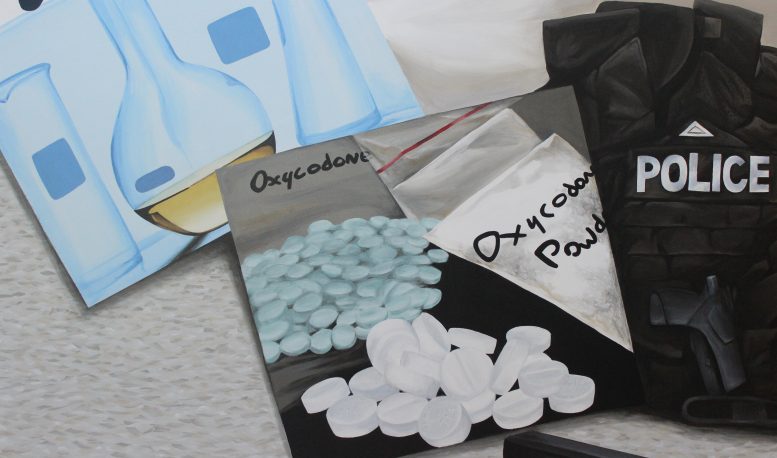By JAN LARSON McLAUGHLIN
BG Independence News
The opiate abuse crisis is not only taking a wrecking ball to families, but it is also wreaking havoc in the workplace.
U.S. businesses lose an estimated $42 billion a year in loss of productivity, according to national statistics. Some companies have difficulty finding employees who can pass the initial drug testing.
“Businesses can’t find employees who are clean,” said Sarad Nerad, community relations with the drug company Alkermes that makes Vivitrol, the drug that helps addicts shake opiates. “This has huge financial impacts on us as employers.”
Then there are the collateral consequences of poor attendance by addicts, accidents on the job, and theft in the workplace.
“As a taxpayer, what does this cost us,” Nerad asked during a “lunch and learn” gathering at the Wood County Educational Service Center about drugs in the workplace.
The statistics presented at the “Dose of Reality” program were grim:
- 20 percent of Americans take five or more prescription drugs.
- 50 percent of those are used improperly.
- In the average U.S. company, 15 to 17 percent of the employees abuse substances.
- Ohio is “way worse than the rest of the U.S.,” Nerad said. Overdose is the leading cause of death for those under 55 in “Generation RX.”
- 217 Americans died while at work in 2016 due to overdoses.
- Nearly half of prime-age men not in the labor force take pain medication daily.
The “perfect storm” of the opiate crisis was created when there was an over-prescribing of opioids, lack of treatment access, poverty, lack of economic opportunities, and health insurance issues, Nerad said.
Hooked on opiates are teens, pastors, farmers.
“It’s not the guy underneath the bridge anymore,” she said. “It doesn’t discriminate.”
Nerad herself is a former addict. She became hooked on opiates at age 15, and by age 17 had been through two treatment programs. She believes in the value of investing in recovery programs.
“There are solutions. There are things we know that help,” she said.
Statistics show that employees in recovery miss less work than the general workforce, Nerad said. For every dollar spent on employee support programs, businesses get more in return.
“They are going to be loyal. They are going to work hard,” she said of recovering addicts.
“Give them a second chance. A job is treatment with a purpose,” Nerad said. “I have a reason to wake up in the morning, shower and show up.”
Nate Kehlmeier, who works for Midwest Recovery, shared a similar story of addiction and second chances. He grew up in Genoa and was a clean kid. His uncle was mayor, his mom served on the school boosters, his neighbor was on the police force.
At age 20, he had a great job, good paycheck, nice apartment, a car and a girlfriend. At age 21, he dislocated his ankle while playing basketball and was prescribed Vicodin.
“That feeling the opiates gave me took over everything,” Kehlmeier said. “I wanted to feel this way every day the rest of my life.”
He had three doctors prescribing opioids for him.
“I was walking around high all the time.”
He started buying Oxycontin – three a day at $50 each.
“All my money went to that,” he said.
It wasn’t long before Kehlmeier lost his job, apartment, car and girlfriend – and moved into his mom’s basement. He began stealing from his family to feed his addiction.
His family held an intervention, and he went to Toledo Hospital for detox. But he managed to have drugs dropped off at the treatment center. “They never caught me.”
Trying to be helpful, his uncle hired Kehlmeier to work at Buckeye Sanitation. By this time, Kehlmeier had switched from Oxycontin to heroin – every day.
“We’ll do anything to get high,” he said. That includes stealing.
“We go after our loved ones first,” Kehlmeier said.
“I robbed him,” he said of his uncle who gave him a job. After stealing from him a second time, the uncle pressed charges and Kehlmeier went to jail for 30 days.
“All I thought about was opiates the whole time I was in there,” he said.
Kehlmeier went to jail a total of four times. In between he was homeless in Toledo, sleeping on floors or couches. He stole from his drug dealer, who responded by shooting six rounds at him.
He hit rock bottom on Dec. 17, 2008, when he bought a lot of heroin and wrote a suicide note.
“The needle clogged on me,” he said.
So Kehlmeier begged a judge to put him in jail. He ended up in a halfway house in Florida. When he got out, Kehlmeier got a job at Wyndham Hotels, working as a bellman, in housekeeping, at the front desk, and with banquets.
“I will forever by grateful,” he said. “He gave me an opportunity.”
Both Nerad and Kehlmeier talked of the value of treatment programs that give opiate addicts second … or more … chances.





